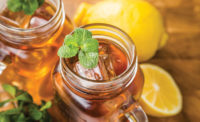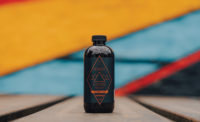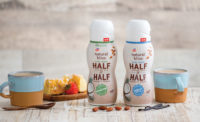You can learn a lot by hanging out at your local coffee or tea shop. You can learn, for example, what all the cool kids are drinking. You can learn which flavors, functional benefits and flights of fancy — cheese tea, anyone? — convince them to part with their hard-earned cash. You can learn how social media influencers catapult café faves to stardom with a single snap. And, you can learn that when it comes to finding ready-to-drink (RTD) coffee and tea inspiration, there’s no better marketplace of ideas than the neighborhood spots where people enjoy these beverages every day.
“Coffeehouses and tea shops are filled with ideas — or filled with people who’re filled with ideas,” observed Philip Caputo, marketing and consumer insights manager, Virginia Dare, New York. “The comfort and freedom these places exude give baristas and other beverage makers the atmosphere their creative minds need to wander and experiment.”
There’s no reason they can’t do the same for creative minds charged with developing RTD teas and coffees, too. Of course, that’s not to suggest that taking beverage concepts from shop to shelf is easy, but it does hint at a resource brands can tap as they get their RTD innovations brewing.
Perking up
In an era of broad discontent with anything “unnatural,” excessively sugary or simply not good for you, coffee and tea offer conscientious consumers a much appreciated alternative.
So it should come as no surprise that the RTD tea and coffee market is “booming,” said Pam Stauffer, global marketing programs manager, Cargill, Minneapolis. She cited data from Grand View Research, which show sales soared to $75 billion in 2016 and look set to reach $116 billion by 2024.
Those numbers mesh with what Stacy DeMars, associate marketing manager for Finlay’s Extracts & Ingredients Inc., Lincoln, R.I., has experienced.
“RTD coffee and tea are both major areas of growth in the marketplace,” she said. “Year over year, we’ve seen positive development in both markets, and there’s no indication that growth will stop in the coming years.”
As for which coffee and tea concepts are grabbing attention, DeMars pointed to cold brew coffee and kombucha as the two largest development areas in each category.
“But we’re also starting to see functional beverages penetrate the space, further contributing to the categories’ growth,” she said.
Welcome home
On the other hand, coffee and tea, Caputo believes, speak to a constellation of desires that animate consumers today.
“Consumers are seeking things that make them feel comfortable and cozy so that they can break from the chaos and daily minutiae of their lives,” Caputo said. “Tea and coffee fit perfectly with this trend. Consumers associate these beverages with homey places — places like their local cafés or their favorite armchair at home.”
Discriminating drinkers
Perhaps more important than knowing who frequents cafés and tea shops is knowing why they’re there, said John Harper Crandall, vice president, sales, Amelia Bay, Johns Creek, Ga.
“Each demographic reflects certain behaviors and drivers all their own,” he said. “For example, baby boomers, in our experience, are more brand loyal and like what they like, whereas millennials seem more willing to try new things. This is where consistent quality and innovation within the category come into play.”
DeMars added that millennials and iGens want a transparent supply chain and frequently say they are willing to pay more for responsibly and sustainably sourced premium coffees and teas.
That gives an advantage to companies that “own the entire supply chain” — like Finlay’s, she said.
“[They] control the process from the field and bush where tea is grown all the way to the final product,” DeMars noted. “That ability to provide full transparency down to the exact location where tea is plucked is exactly the kind of assurance our consumers look for.”
The real thing
Closely allied with consumers’ interest in transparent tea and coffee sourcing is their interest in authenticity.
“This is most evident in the tea space, where there’s growing demand for products that are brewed and true to the actual tea leaf itself,” DeMars noted. The company’s new research and development center for tea develops “slow and careful” processing techniques that yield real brewed tea in line with these emerging standards.
Amelia Bay follows a similar processing path, using only the finest leaf tea directly purchased from trusted growers across the globe, Crandall said.
“And we’re proud of the fact that only pure water touches the raw leaf — for quality taste and a label that’s as clean as can be,” he said. “Clean and clear labeling has topped the list of food and beverage trends for several years with no signs of slowing down, and high-quality ingredients are here to stay.”
Make it snappy
More than anything else, though, the force driving consumers to RTD coffee and tea is sheer expediency.
“While not much beats a freshly brewed cup of espresso, when strict schedules dictate so many aspects of our lives, convenience can be a winning factor for RTD options,” Caputo said.
DeMars agreed, noting that today’s consumers — millennials, in particular — have fast-paced lifestyles.
“Always on the go, they’re shifting traditional consumption patterns, generating higher demand for formats that are easy to grab and go,” she said. “This is why RTD coffee and tea continue to see growth.”
Even so, the RTD options most likely to gain traction are those that take their cues from the cafés and tea shops that consumers haunt when they’re not in a hurry.
“Consumers love and seek out unique taste experiences,” Caputo noted. “And these are extremely prevalent in the coffee and tea spaces where new, creative concepts appear on menus and shelves frequently.”
Frontlines of functionality
After all, that’s where kombucha got its start, right? It’s enjoying “explosive growth” at retail, DeMars said, with shelf space increasing more than fourfold over the past few years.
“As the market continues to trend toward premiumization with a focus on health and wellness,” she added, “we expect continued growth and flavor innovation in the next few years.”
Herbal teas are also gaining strength, especially when boosted with botanicals and ingredients that purport to bring functional benefits.
“We’re seeing top brands like Lipton, Bigelow and Twinings emerge with lines of functional teas in the hot tea category, and soon we expect this premium tea offering to cross over into the RTD space,” DeMars predicted.
Crandall noted that traditional tea varieties such as black, white, green and rooibos are still popular, but acknowledged tea’s tilt toward functionality. His company has seen growing demand for ingredients such as ginseng, guarana and superfoods.
“Our R&D support and technical experts design and balance functional formulations made with polyphenols, vitamins and other supplements thought to provide benefits such as energy-boosting, anti-inflammatory, relaxing or antioxidant properties,” he said.
Coffee concepts are embracing functionality, too. Arla Foods Ingredients, Sønderhøj, Denmark, developed a whey-protein-fortified iced coffee concept that delivers 20 grams of whey protein — using the company’s branded Lacprodan DI-7017 whey protein ingredient — per 350-milliliter serving.
“As well as offering satiation on the go, it contributes to the building and maintenance of muscle mass and function,” said Anne Louise Friis, business development manager for health and performance nutrition at the company.
The formulation also supplies calcium and phosphorous via Arla’s branded Capolac milk minerals. And the beverage’s base — made from real coffee beans — kicks in a dose of natural caffeine similar to what you’d find in one to two cups of espresso, Friss said.
Though functional coffee appeals to some consumers, others simply want less sugar in the creamy concoctions they find so hard to resist at Starbucks. That’s why Cargill developed a no-sugar-added Mexican chocolate mocha cold brew coffee to feature at SupplySide West.
“Consumers are paying more attention to sugar content, yet still enjoy a bit of sweet in their coffee-based creations,” said Leanne Wortman, a senior food scientist at Cargill.
Cargill’s creation combined coffee, almond milk, chocolate and hints of cinnamon with the company’s EverSweet Reb M and Reb D stevia sweetener “to dial in the optimum sweetness level for a balanced mocha drink,” Wortman said, and erythritol to round out the sweetness and accentuate the spicy cinnamon.
Trending textures
Functionality isn’t the only story in RTD coffee and tea. Anu Fisher, marketing analyst, Flavorchem, Downers Grove, Ill., sees “a new approach to textures” as likely to set trends in the tea sector. Case in point: Carbonated and nitrogen-infused teas are picking up where nitro coffee left off.
“Beverages that offer textural complexity without the sugar or calories of traditional carbonated soft drinks will have an advantage,” Fisher said, “especially if there are other nutritional benefits.”
Another concept that’s piggybacking on nitro’s success is sparkling coffee, which DeMars sees as a new trend in novelty textures. The whole concept started as a coffee-spiked mint julep “experiment” at a Stumptown Coffee Roasters in New Orleans, she explained.
“Now, brands like Stumptown, La Colombe and Rise are formulating RTD sparkling coffees with new flavors not seen in a coffee application before,” she said.
Sitting pretty
Score another point for hip cafés — which, it’s worth noting, are responsible for making “latte art” de rigueur. And that plays into another trend that Fisher wagers will influence RTD developments: eye appeal.
“Visuals are extremely important,” she said. “Satisfying the visual sense that younger consumers seek, we’ll see more hashtags for bright, colorful teas on social media.”
iGen consumers, in particular, embrace technologies that make interactivity and documentation essential parts of everyday life, Fisher noted. So with more consumers snapping shots of their, er, shots, she predicts that eye-catching color and functionality will merge as RTD ingredients. Think blue algae, beetroot and purple tea from Kenya — the latter of which Fisher calls a relatively new ingredient billed as having more antioxidants than green tea does.
Survival skills
But how will all this taste? After all, the more “stuff” you add to a coffee or tea — and the more you process it en route to putting on a shelf — the harder it is to keep its flavor profile at its made-to-order peak.
That’s because the retail shelf is simply a more threatening environment to finished product quality than is the café or teahouse.
“Made-to-order environments have the advantage of using fresh ingredients in beverages intended to be consumed immediately,” Caputo said, “whereas bottled beverages have to maintain fresh flavor and nutrient quality while ensuring shelf life.”
Hilary Hursh, R&D manager for Finlay’s, agreed, noting that most RTD beverages go through some sort of heat treatment process that can change the flavor profile by adding cooked notes and reducing top notes such as a fresh-brewed coffee aroma.
“Likewise, an RTD product with a six-month shelf life will experience flavor changes over time that wouldn’t occur in a freshly prepared product,” she said.
To overcome these challenges, beverage developers should understand how heat and time affect their formulations, and they should work with suppliers to minimize those effects. For example, Hursh said, a buffering agent could help mitigate souring that can occur over time in cold-brewed coffee beverages.
Caputo added that methods such as high-pressure processing were invented to preserve taste, color and nutritional profiles with non-thermal cold-processing techniques. And that’s no idle matter.
“If a drink doesn’t taste good, consumers likely won’t adopt it into their daily nourishment routines,” he said.






